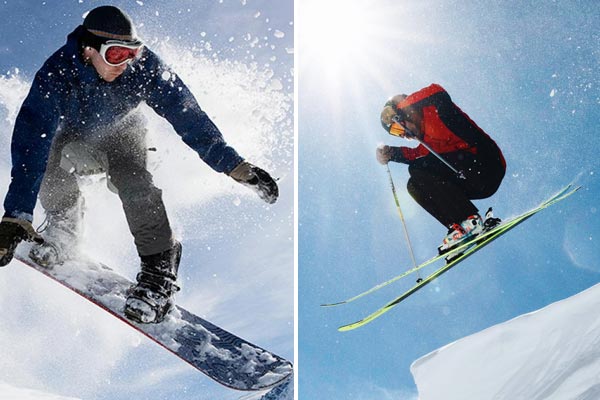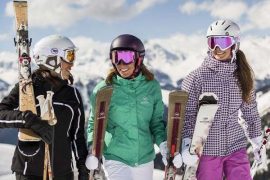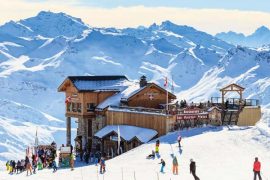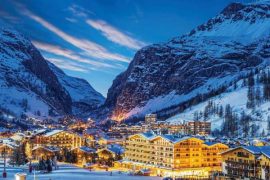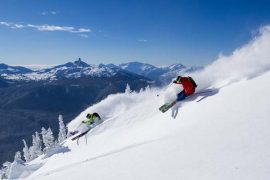Skiing and snowboarding entail the acts of moving over snow using boards as well as your feet. They are practiced mostly as recreational activities or as sports activities.
In skiing one uses a pair of skis to travel over snow whereas; in snowboarding one moves on snow on a single board attached to the boots.
Both sports activities have advantages such as enhancing social skills and shortcomings such as the risk of injuries to the participant.
How to decide, skiing vs. snowboarding
When someone decides to head to the slopes for the first time, a decision has to be made, that is whether skiing or snowboarding.
Skiing is more comfortable between the two while snowboarding has a lot of fun once the participant masters it correctly.
The following factors will help one decide what to choose; asking somebody who has tried both of them.
They will give information such as; skiing is more comfortable to pick up and quicker to get to a reasonable skill level.
Snowboarding is a little bit harder for first-time learners, and the latter can become disillusioned by such devices. Besides, injuries are arising from accidents during either of the two practices.
Accidents sometimes occur, and according to Dr. Tim Greene, it is essential to know the method which can result in more injuries than the other and the intensity of the injuries that are likely to happen.
Skiing and snowboarding for beginners
Learning the tactics required can be a bit hard for a beginner, but once one works it out and they begin to master them, they begin to ski the mountain all through within a short time.
The learner needs to undergo a proper snowboarding lesson which requires a lot of time.
An instructor can help the beginner get certain useful guidelines on standing up, descending downhill, toping and the ABCs of turning.
Wear the right clothing
Appropriate clothing should be won when going to snowboarding, inside the snow doom is quite cold, and therefore the type of apparel chosen should suit the weather and the cold temperatures.
One should wear thermal base layers on the top and bottom half, then followed by a jumper.
Also, wear appropriate snowboarding jacket as well as snowboarding trousers which are water resistant and windproof to avoid the participant from being wet and cold along the slopes. Also, wear goggles and helmets unless it is an indoor dome advises Dr. Haider.
Wear protective gears
There is a high probability of a beginner to fall down severally during skiing and snowboarding.
As a result, there is a need to have the proper gears to protect the person’s body when learning the acts.
Helmets are highly recommended when a person is learning, hitting your head can be a severe and painful experience according to Dr. Jasper Shealy.
Conversely, and the helmet possibly will be the distinction between concussion and hospital admittance.
Wrist guards can be won to help prevent wrist injuries.
Impact shorts should be worn; they provide cushioning under the butt.
Work out whether you’re goofy or regular
Working out the stance one it helps them determine their front foot and their foot on the snowboard Dr. Stokenstein recommends.
Goofy refers to those people who ride the snowboard with their right foot in front while being regular refers to those who ride with their left foot forward.
Learn to fall properly
Beginners lose balance frequently when learning. It can be scary at first but they should learn how to fall forward and down properly to avoid injuries. When one falls they should avoid putting their hands out to break their fall.
This could injure the participant on the wrist According to Dr. Keith Jacobson; instead, they should keep their hands close to their body, crossing over their chest.
This will prevent injuries and make skiing and snowboarding to be more fun.
Learn to Skate
As soon as one is one is not moving on a flat region of the mountain while moving towards a chairlift, the participant needs to remove one foot from the fastenings and ski alongside the snow.
It is important to take the back foot off the bindings thus the front foot will be strapped in.
The next step is to take your back foot ahead of your board and push frontwards like in the example of skateboards.
Immediately one starts moving forward, skating through the snow and directing the board with the front foot.
One should practice regularly because it may take a while to feel at ease skating.
Learn the piste symbols
Mountain slopes are usually recorded to show whether they are right for learners or not. The green hills are typically the most comfortable slopes, ideal for beginners.
Then the blue slopes follow on the upper side.
They are to some extent steeper and help in making the progression from a beginner to intermediate.
Next is the red slopes which are numbered in all countries. They are often other steep with moguls’ occasionally.
Lastly, we have the black slopes, these are the toughest runs. They are usually steep, frequently bumpy and commonly reserved for experienced snowboarders and skiers.
Always look at the direction in which you are taking
As a beginner, one will be tempted to gaze at the ground as you ski. Dr. Owens advises that one should be focused and keep the eyes looking forward in the direction in which you are moving to.
One can see what is in front of them and then decide the next step to take. Maximum concentration is also important and fewer distractions.
Benefits of skiing and snowboarding
- Allows for an appreciation of nature, being on the mountain and a part of life helps people understand that they are a part of life. The beauty and wonders of nature around them creates a sense of appreciation.
- Improves one’s mood, exercising is known to increase peoples mood, skiing and snowboarding are no exceptions.
- Teaches perseverance, skiing takes a tremendous amount of devotion and determination Healthy competition it provides an opportunity for healthy competition with, friends,
- parents and also siblings.
- Improves balance and coordination, when learning skiing or snowboarding, the participant has to use the core muscles to stay up when also using their leg muscles to move the skies safely down the mountain.
- Enhances social skills, both are accurate social skills; one must respect the fellow participants and learn to interact with others appropriately on the slopes.
- Increases body awareness, it teaches how to use each body part separately, and in sync
- with each other, thus, people get aware of each piece of their bodies and where it is in
- space.
- Promotes deep sleep.
- Increases cardiovascular endurance.
- Skiing puts you in a constant squat position, and it works the inner and outer thighs and quads.
Differences between skiing and snowboarding
In skiing, the participant uses a pair of skies for traveling on snow whereas, in snowboarding, the partaker descends on a snowy slope with a single snowboard attached to their feet.
A snowboard is attached to the foot of the rider using a particular boot unlike in skiing where a pair of skis is appended to the shoes using binding.
Styles employed in skiing include; freestyle, alpine, military and Nordic.
However, snowboarding uses rail raiding styles;
- freeriding,
- jibbing
- free carve style.
Snowboards navigate better in powder and crud, they are at ease on the knees however the partaker can end up with injuries on the wrist, and skis are however navigated on ice and bumps, a fall is likely to injure the knees according to Dr. Maak.
Pros and Cons of skiing and snowboarding
Snowboard cons
- Skis are more efficient than snowboards
- Generally, more terrain can be accessed with skis than snowboards, which is the main reason why backcountry guides are mostly on skis than snowboards.
- Skis are usually better on ice or hard park with their two edges
Snowboard pros
- It is easier to tackle more difficult terrain on a snowboard because you don’t have to
- Worry about losing a ski.
- There is a solidarity among snowboarders which hardly exists to the same degree with
- Skiers.
- There is excellent fun in more varied conditions and gradients on a snowboard than skis.
- Skiing pros
- There is more accuracy control especially at high speeds because of having two edges
- vs.one for turning.
- It is easier to do glades and moguls.
- Presence of poles makes it help with maneuverability and stability.
Skiing cons
- Different surface types often cause poor transitions mostly when one ski is on one kind of surface, and the other is on another.
- Some people don’t feel comfortable in those boots.
- Skies can move independently if caught by such a circumstance some awkward wipeouts can arise.
- More comfortable to learn.
skiing vs. snowboarding
Skiing is simple to learn according to Dr. Shealy’s study but hard to master while snowboarding is harder to learn as a first timer but more comfortable to master.
With skiing, a beginner’s technique can be broken down into a modular approach, but its perfection will require you to become extremely technical.
In snowboarding, it is all about getting to the edges which is the hardest part.
However, once it is achieved, one has the critical technique of the sport nailed and can reach a pretty remarkable level more quickly, most probably if one is bold.
More fun, skiing vs. snowboarding
Skiing is more fun than snowboarding. The reason is that skiers become more immersed in their activity when moving down a slope than snowboarders.
It is assumed that flow directly leads to increased satisfaction with both sports activities.
Also, skiers have more means of pleasure and involvement compared to other participants enjoying snowboarding or both of them.
The speed of skiing vs. snowboarding
Skiers go faster, the current speed-skiing records are over 250kph against 200kph for snowboards, and therefore it is clear that the skiers jump higher than the snowboarders.
When a snowboarder over when hurtling at speed, his frame is then kept intact on a single plane by dint of both legs being locked in place on one board.
The heavier the body weight of an individual is, the more their bodies are likely to resist the state of motion. As a result, they move faster.
Snowboarding is less dangerous than skiing
Skiing involves two skiers, one for each foot, which is disconnected to one another and is most commonly ridden with ski poles at your side of pushing. This seems like an extreme risk, if the skis get crossed, one is projected forward.
In case of loose control, there is a high probability that one will be passing the skis making one fall.
Besides, two poles are in the participants’ hands that can cause harm to them if they get in their way when falling or a snowboarder, their feet are both secured to one board, and if they lose balance, there is a possibility of slipping onto their stomach or butt according to Dr. Shealy rather than crossing the skis and create a face indent into the snow in front of the participant.
Skiing and snowboarding injuries
Skiers are likely to have knee injuries caused by twisting motion during falls says Dr. Richard Dawood.
Snowboarders tend to have more casualties on the upper parts resulting from falling on outstretched hands.
Other injuries may occur on the head, neck, and shoulders such as shoulder separation and dislocation.
Both sports activities are fun and should be carried out despite the challenges encountered, and the beginner should be keen to learn and understand the techniques required.
People should be encouraged to participate in both sports because of the many benefits accrued to them.
